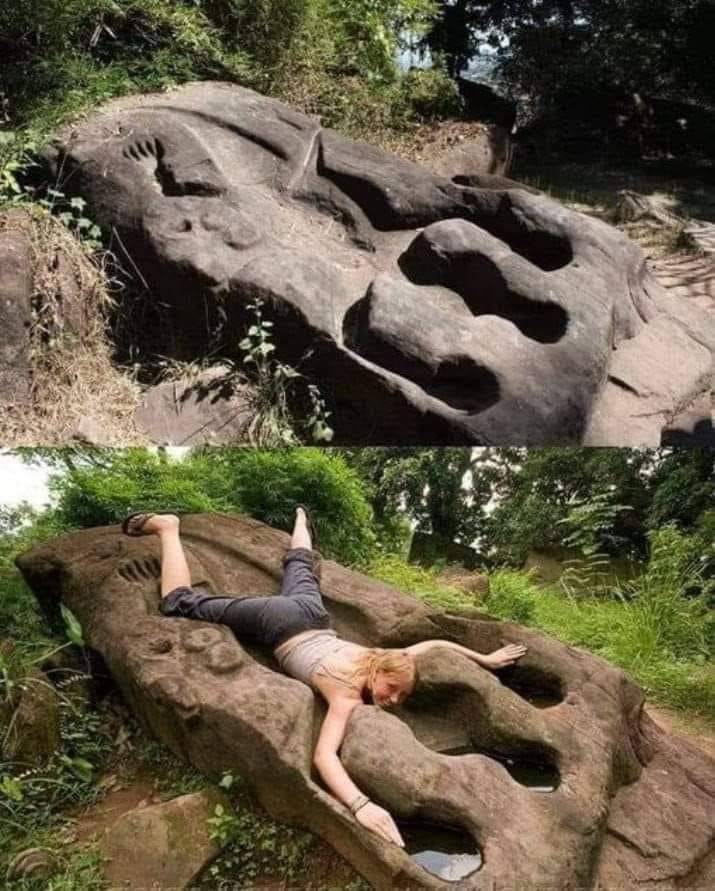The Enigmatic Crocodile Stone of Vat Phou: Ancient Rituals and Mysteries
Deep within the lush landscapes of Laos lies the Vat Phou Temple complex, a UNESCO World Heritage site, home to one of the region's most intriguing relics: the Crocodile Stone. This peculiar rock formation, carved to resemble a crocodile, has long fascinated historians, archaeologists, and travelers alike. The stone, steeped in history and mystery, hints at the possibility of ancient, once-sacred rituals that predate even the famous Angkor civilization of Cambodia.
A Glimpse into Pre-Angkorian Times
Before the 9th century CE, long before Angkor Wat's majestic towers dominated Southeast Asia’s landscape, the Khmers were already shaping a rich cultural heritage in Laos, with Vat Phou serving as a vital religious and ceremonial hub. The complex, located at the base of Phou Khao, or "Sacred Mountain," was not just a place of worship but a focal point for the community's spiritual and possibly sacrificial rites. The Crocodile Stone stands out as one of the site’s most enigmatic features.
This stone is unusual due to its crocodile-shaped carving, believed to symbolize the cycle of life, death, and rebirth in the natural world. In the pre-Angkorian world, crocodiles were seen as powerful creatures, revered and feared. Their image embodied a potent blend of spirituality and raw nature, linking the earthly realm to the divine. This reverence might explain why a crocodile was chosen for such a significant ceremonial rock.
Theories of Ancient Sacrificial Rituals
One of the most striking theories surrounding the Crocodile Stone is that it may have been used in human sacrifice rituals during pre-Angkorian times. Archaeologists have suggested that the stone’s flat surface, carved to resemble a crocodile, served as an altar where offerings were made to the gods. According to this theory, an annual ritual may have involved the sacrifice of a human life in reverence to the divine powers, to ensure prosperity and protection for the community.
These sacrificial ceremonies, if they indeed took place, were likely steeped in symbolism. In ancient Khmer culture, offerings were thought to appease the spirits, especially in locations as spiritually charged as Vat Phou. Sacrifices were seen as an ultimate expression of devotion, believed to establish harmony between humans and the deities who governed nature and fate. Whether these ceremonies actually involved human sacrifice remains speculative, yet the legend endures, adding to the Crocodile Stone’s mystique.
Preserving a Sacred Legacy
The Crocodile Stone continues to be a focal point of Vat Phou’s spiritual aura. While the practice of human sacrifice is long gone, the stone still draws locals and tourists who come to pay homage or simply marvel at its ancient craftsmanship. It reminds us of a time when people believed deeply in the power of nature and the divine, intertwining their lives with the natural world around them.
Today, Vat Phou and the Crocodile Stone stand as enduring monuments to the ancient world’s complex rituals and spiritual beliefs. They invite us to reflect on the mysteries of the past and the legacy of a civilization that left few written records but profound symbols of devotion. This relic of a bygone era continues to capture imaginations, reminding visitors that history is sometimes carved in stone, waiting patiently to share its stories.
For more fascinating insights into ancient mysteries and cultural heritage, follow KM LORD BLOG.


